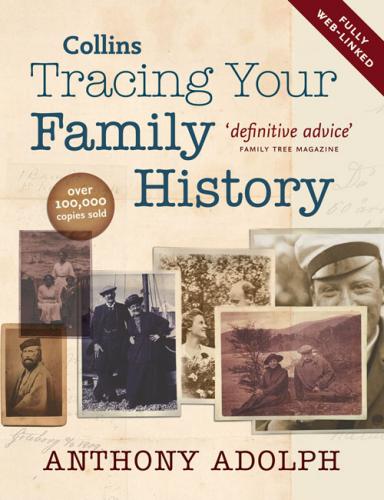It’s a good idea to try to relate the events in the family to the world around them:
This is a valuable exercise, which might actually help you find out more about them, or highlight inaccuracies or even mistakes in the family tree. It is also a good reminder that these were real, breathing people who existed in the world, not as pale shadows on old, dusty records. Indeed, if you think your ancestors only existed within the confines of parish register entries and, now, the forms generated by genealogical computer programs, it’s unlikely you will gain very much from family history, or that other people will enjoy and benefit from your hard work. The more you can think of and convey the idea of your ancestors as real human beings, the more fun – and success – you’re likely to have.
PRESENTING YOUR RESULTS
HERE IS THE SAME information about the Fairfax family, presented as a narrative pedigree, a prose account and a traditional family tree.
NARRATIVE PEDIGREE
John Fairfax, born about 1710, married Mary Hayward on 16 September 1735 at Framlingham, Suffolk. He was a draper and grocer of Coddenham and wrote his will in 1751, naming his executors as his wife Mary and brother-in-law John Hayward. It was proved 2 June 1758 (Suffolk Record Office IC/AA1/184/49). His children (details of which are recorded in the family bible) included:
1. Frances, born 24 May 1736, baptised 25 May and died 31 May, Stowmarket.
2. Mary, born 9 June 1738, baptised 26 June at Stowmarket.
3. John Fairfax, born 30 June 1739, died 15 weeks old, buried at Stowmarket.
4. John Fairfax, born 30 August 1741. Left a watch by his father. Married Penelope Wright at St James’s, Bury St Edmund’s, on 5 May 1770. Elected freeman of Bury St Edmunds, 1802. Death recorded in Gentleman’s Magazine as being in a fit on 12 February 1805 while visiting ‘a friend [sic], Mr P. Nursey, at Little Bealings’. He had two children:
1. Penelope, born on 17 April and baptised on 31 May 1771 at St James’s, buried on 30 June 1787 at Bury St Edmunds.
2. Catherine, born on 6 November 1772 and baptised on 3 December 1790 at Bury St Edmunds by Rev. Mr Sharp, as is recorded in the family bible.
5. Catherine Fairfax, born 7 September 1742 and baptised by Mr Meadows. Inherited share of a messuage in Kettleburgh from cousin Katherine Fairfax in 1747/50. Married John Nursey by licence on 4 April 1764 at Coddenham, before witnesses John and Mary Fairfax; he was described as a surgeon of Coddenham and she as daughter of John Fairfax of Coddenham, a draper. Died at Wickham Market on 13 April 1827, aged 85. No will has been found in Suffolk. They had children, including the landscape artist Perry Nursey (baptised on 25 June 1771 at Stonham Aspall).
Catherine Nursey, née Fairfax, mother of the Suffolk landscape painter Perry Nursey. Picture owned by her descendant Mrs Nancy Bedwell.
PROSE ACCOUNT
THE LIFE OF JOHN FAIRFAX
JOHN FAIRFAX was born in 1710, four years before the death of Queen Anne ushered in the reign of George I and the start of the Hanoverian period. Growing up in rural Suffolk, he was variously described as a grocer and draper in the village of Coddenham, indicating either an enterprising mind or (less likely in view of the relative prosperity of his children) an inability to find the right niche in life. He married Mary Hayward on 16 September 1735 at Framlingham, a market town some ten miles from Coddenham, and, indeed, going to market there may have been how he met her. He wrote his will in 1751, making her and her brother John his executors, and it was proved, indicating he had died by then, in 1758, two years before the death of King George II.
John’s children included Frances, Mary, two Johns and Catherine, of whom Frances and the first John died young. To his surviving son JOHN FAIRFAX he left his watch ‘that was my cousin Smith’s’ and £63 to apprentice him ‘to some proper business at a fit age’. This younger John married Penelope Wright at St James’s, Bury St Edmund’s, on 5 May 1770 and obviously benefited from his apprenticeship, as he became a freeman of Bury St Edmunds in 1802. He died in a fit on 12 February 1805 while visiting his nephew, the artist Perry Nursey, at Little Bealings. He had two children, Penelope and Catherine.
John senior’s daughter Catherine, born 7 September 1742, received a bequest of land from her father’s cousin Catherine Fairfax in 1750 and, perhaps as a result of this, made a good marriage to the local surgeon, John Nursey of Coddenham. They married there by licence on 4 April 1764. She was mother of the artist Perry Nursey (baptised on 25 June 1771 at Stonham Aspall), at whose house her brother died in 1805.
FAMILY TREE
CHAPTER THREE ANCESTRAL PICTURES
Most of this book is about finding records of ancestors. Pictures can be records, too; even a photographer’s address on the back of an old snap could provide a clue as to where the depicted ancestor came from. But they are also valuable in their own right as a fantastic way of bringing your family history to life.
My cousin Ernest Rietschel of Dresden, a renowned German Sculptor, who was born in Pulsnitz in 1804 and died in Dresden in 1861.
Before the invention of photography in the 19th century, some of our ancestors were depicted in paintings, sketches, silhouettes and even busts and sculptures. From grand Van Dycks to amateur scribbles, such pictures are always worth seeking out, for, especially in family history, a picture really can be worth a thousand words.
WHERE TO SEARCH
PAINTERS AND PAINTINGS
